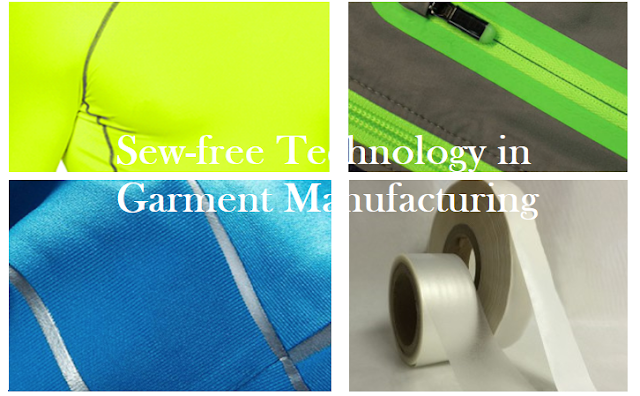Sewing has been one of the oldest of textile arts and has been the basics for garment construction since then. But the use of thermoplastic or hot melt adhesive films have started to revolutionise the way of garment construction and has become the next generation of cut and sew. In this article, I will discuss heat sealing, sew-free seaming technology along with the pros and cons of the sew-free technology.
What is seam sealing or sew free seam?
Seam sealing is a process of sealing up of the seam generally with a silicone coat or tape with a purpose of waterproofing the seam. But with the use of elastomeric adhesive tapes, this extra step of coating has been removed altogether and the tape gets fused directly onto the seam removing the need for stitch. It can be also used in normal garments for panel attachment, side seams, pocket and placket attachments etc. sew free seam can be done using bonding, welding method too.How the seam sealing (Sewfree seam) works?
Sew-free seaming has been possible because of these special elastomeric adhesive tapes. These tapes on heat and pressure activate the adhesive through the fabrics melting through the structure of it. The activation of the adhesive can be done through an iron press, seam sealing machine. It can bond almost all non-fleece fabrics (nylon, polyester, cotton, leather membrane etc.) with some limitation such as silicone, porous materials like fleece and so on.There is another technology wherein high-frequency mechanical oscillations cause molecular and interface friction in the joining zone. This creates the heat required for welding and the material is plasticised. This allows for brief cooling times, whilst maintaining the welding pressure and this is called ultrasonic roll seam welding. The only disadvantage of it being it can only be used for garments containing thermoplastic fibres.
Application of seam sealing technology:
The use of thermoplastic technology has used in sportswear apparel, intimate apparel, yoga apparel and many regular apparel items etc. The application of sew-free technology is not been limited to apparels only but also used in bags, shoes, material for medicals, tents, gloves etc. including waterproof seam sealing, sew-free pocket adhesive, zipper bonding, front zip sealing, fabric joining, line bonding, overlay taping along with adhesive backing for woven level and embroidery.You can read more about the application of sew-free garment making at Bemis.
 |
| Image source: images are taken from various websites |
Seam sealing and bonding machines for apparel product manufacturing
Some of the prominent brands like H&H Asia Group, Foxsew, Zeuya, Yanhan are currently providing heat sealing machines, continuous bonding machine and solution for apparel product manufacturing.Benefits of seam sealing techniques
The benefits of using sew-fee garment making using heat sealing or other methods include
1. Improved appearance and performance: With the help of hot melt procedure the bulky sewn is replaced with seams having optimum stretch and recovery while maintaining the sleek, smooth profile in the seams and hems. Without the sewn there will also be a less chance of chafing providing more comfort to the wearer.
2. Lightweight: Sew free seams can be up to 6% lighter than traditional threaded seams. When wet, it will absorb 50-60% less of its original weight which will exclude the threads soaking up water.
3. Durability: It has found that sew-free seams are just as strong, or even stronger than sewn seam. Often, it’s the fabric that has given up before the seam.
4. Waterproof: With heat sealed bond stitched seam has been replaced with a razor thin molecular bonding process which for waterproofing earlier required an extra seam-sealing tape due to needle holes.
5. Fabric consumption: With traditional garments, for having a proper strong seam there has to be a specified seam allowance; but with this, no such allowance will be required as it will be bonded through the outline reducing fabric consumption.
With all these advantages, there has been a major disadvantage that I have found. And that is the speed of the process. The problem faced with this technology is the same that of fusing as the parameters of both remain the same. For the adhesive to melt, it will require a specific time, and this will lower the production rate and its application.
2. Lightweight: Sew free seams can be up to 6% lighter than traditional threaded seams. When wet, it will absorb 50-60% less of its original weight which will exclude the threads soaking up water.
3. Durability: It has found that sew-free seams are just as strong, or even stronger than sewn seam. Often, it’s the fabric that has given up before the seam.
4. Waterproof: With heat sealed bond stitched seam has been replaced with a razor thin molecular bonding process which for waterproofing earlier required an extra seam-sealing tape due to needle holes.
5. Fabric consumption: With traditional garments, for having a proper strong seam there has to be a specified seam allowance; but with this, no such allowance will be required as it will be bonded through the outline reducing fabric consumption.
With all these advantages, there has been a major disadvantage that I have found. And that is the speed of the process. The problem faced with this technology is the same that of fusing as the parameters of both remain the same. For the adhesive to melt, it will require a specific time, and this will lower the production rate and its application.
